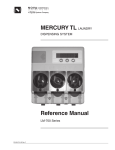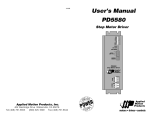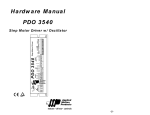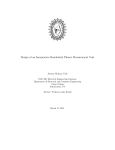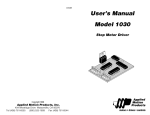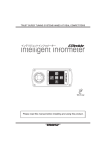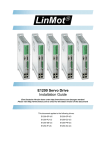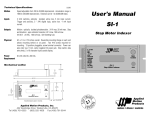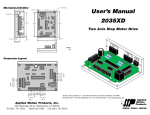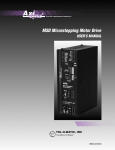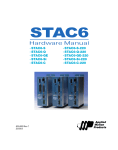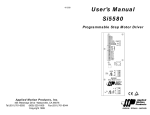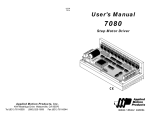Download PDO 5580 - Applied Motion
Transcript
8/28/00 Mechanical Outline User’s Manual 8.00 " SPEED+ SPEEDTACH+ TACH– CW WPR CCW 90V pk POWER HIGH SPEED DIR+ DIR– STEP+ STEP– EN+ EN– FAULT+ FAULT– 0.2 0.4 0.8 1.6 2.0 JOYSTICK EXT SPEED 50% IDLE CURRENT (BASE = 0.5 A) 1.25 " 3.00 " PDO 5580 1 2 3 4 5 6 7 8 1 2 3 4 5 6 B– B+ A– A+ OSC BYPASS SELF TEST ACCEL LOW SPEED MOTOR G L N TEMP STEPS/REV SHORT PDO 5580 Step Motor Driver AC POWER 3.07 " Step Motor Driver 8.97 " 9.25 " 0.06" 2.15" DIR+ DIR– STEP+ STEP– EN+ EN– FAULT+ FAULT– SPEED+ SPEEDTACH+ TACH– CW WPR CCW 0.25" POWER TEMP SHORT 5.45 " CURRENT (BASE = 0.5 A) 1 2 3 4 5 6 HIGH SPEED LOW SPEED 2.02 " 0.2 0.4 0.8 1.6 2.0 1 2 3 4 5 6 7 8 5.30 " JOYSTICK EXT SPEED 50% IDLE ACCEL STEPS/REV OSC BYPASS SELF TEST MOTOR 90V pk B– B+ A– A+ PDO 5580 Step Motor Driver AC POWER G N L Applied Motion Products, Inc. 404 Westridge Drive Watsonville, CA 95076 Tel (831) 761-6555 (800) 525-1609 Fax (831) 761-6544 motors • drives • controls Introduction Technical Specifications (continued) Thank you for selecting an Applied Motion Products motor control. We hope our dedication to performance, quality and economy will make your motion control project successful. If there’s anything we can do to improve our products or help you use them better, please call or fax. We’d like to hear from you. Our phone number is (800) 525-1609 or you can reach us by fax at (831) 761–6544. Features • • • • • • • • • • • • • • • • • Digital oscillator provides smooth accel/decel ramps and precise speed control. Powerful microstepping amplifier provides high torque and smooth, quiet motion. Accepts a wide range of motors: NEMA sizes 14 - 42, 0.5 to 5.5 amps/phase. Easy to configure with on-board switches and potentiometers for all settings. Automatic idle current reduction reduces motor and drive heating, saves power. Pluggable screw terminal connectors make wiring easy. Oscillator Mode operates from internal pots, external pots, 0 - 5 V analog signal, or analog joystick. Two speed ranges, can be selected “on the fly” by a digital signal with automatic ramping between speeds. Inputs and outputs are optically isolated, differential (sourcing or sinking). Speed & Enable 5 - 24V, Step & Direction 5 - 12V. Tach Out signal allows easy measurement of speed. Enable input allows motor current to be shut off on command. Built in 80 volt power supply (accepts 110 or 220 VAC power, 50-60 Hz) MOSFET pulse width modulation switching amplifiers (3 state) Microstepping pulse & direction mode with 16 step/rev settings from 200 (full step) through 50,800. Overtemp and overcurrent (short circuit) and surge protection Built-in self test for troubleshooting. CE and TUV compliant. -2- Recommended Maurey Instrument Corp., Chicago, IL (773)581-4555 JS31462S5T3 (2 axis) or SAJ2515-F-502 (1 axis) Joystick Speed Ranges LO speed range: 0 - 5 rev/sec HI speed range: 0 - 25 rev/sec Accel/decel range: 1 to 250 rev/sec/sec Physical Constructed with black anodized aluminum heat sink and heavy gauge steel housing. 3 x 5.3 x 8 inches overall. 7.8 lbs. Ambient temperature range: 0 - 70 C. Power, temp and motor short circuit LEDs. Mounting brackets and switch cover included. See back cover for detailed drawing . Connectors European style, pluggable screw terminal blocks. Motor: 4 position. Wire size: AWG 12 - 28. Signal Input/output: 8 position. AWG 16 - 28. AC Input: 3 position.Wire size: AWG 12 - 28. CE Mark Complies with EN55011A, EN50082-1(1996), EN50178 (1997). -23- Technical Specifications Amplifiers Dual, MOSFET H-bridge, 3 state, pulse width modulated switching at 20 kHz. 0.5 - 5.5 amps/phase output current, switch selectable in 0.2 increments. Overcurrent and overtemperature protection. Automatic idle current reduction (defeatable), reduces current to 50% of setting after one second. Minimum motor inductance is 0.8 mH. Power Supply Linear, toroidal transformer based for high reliability and low noise. 110 or 220 VAC input, switch selectable. 50-60 Hz. DC voltage at nominal line voltage: 75 VDC full load, 90 VDC no load. Inputs Speed, Enable: optically isolated, differential 5-24V logic. 2200 ohms internal resistor. Getting Started To use your Applied Motion Products motor control, you will need: ✔ a power cable (line cord) ✔ a compatible step motor (see page 21) ✔ a small flat blade screwdriver for tightening the connectors - an Applied Motion Products screwdriver suitable for this purpose is included with your drive. For pulse & direction mode: ✔ a source of step pulses (usually an indexer is used) For oscillator mode: ✔ an instrument for measuring motor speed (tachometer, freq. counter or o-scope) For joystick mode: ✔ An analog joystick The sketch below shows where to find the important connection and adjustment points. Please examine it now. All mating connectors are included. Step, Direction: optically isolated, differential 5 - 12V logic, 680 ohms internal resistance. (24V with external 1000 ohm resistors) I/O connector SPEED TACH OUT EXTERNAL POT /JOYSTICK/0-5V ANALOG SPEED POWER TEMP SHORT JOYSTICK EXT SPEED 50% IDLE CURRENT (BASE = 0.5 A) Tach & Fault: Optically isolated, uncommitted (open collector, open emitter) photo transistors. 30V, 20 mA max. Tach output is 100 pulses per motor revolution, 50% duty cycle (square wave). Microstepping Oscillator/joystick modes: 1/64 step (12,800 s/r) with 1.8° motor. Pulse & Direction mode: 16 switch selectable resolutions: 200, 400, 1000, 2000, 5000, 10000, 12800, 18000, 20000, 21600, 25000, 25400, 25600, 36000, 50000, 50800 steps/rev. Self test: 1/2 step. -22- HIGH SPEED LOW SPEED ACCEL potentiometers OSC BYPASS SELF TEST ACCEL/DECEL RATE LOW SPEED HIGH SPEED LEDs POWER OVER TEMP FAULT MOTOR SHORT switches STEPS/REV MOTOR CURRENT IDLE CURRENT EXT/INT POT JOYSTICK MODE switches MOTOR 90V pk B– B+ A– A+ PDO 5580 Step Motor Driver AC POWER Outputs 0.2 0.4 0.8 1.6 2.0 1 2 3 4 5 6 In pulse & direction mode, motor steps on falling edge of step input. 0.25 µsec minimum pulse, 2 MHz max step rate. 1 µsec minimum set up time, 50µs minimum hold time for direction signal. DIRECTION STEP ENABLE FAULT 1 2 3 4 5 6 7 8 Wiper: 0 - 5 VDC analog signal. Max recommended pot/joystick impedance: 1K - 5K ohms. Joystick dead zone: ± 80 mV. Potentiometer/analog signal dead zone: 40 mV. I/O connector DIR+ DIR– STEP+ STEP– EN+ EN– FAULT+ FAULT– SPEED+ SPEEDTACH+ TACH– CW WPR CCW STEPS/REV OSC MODE SELF TEST connector MOTOR G connector N AC POWER L -3- Connecting the AC Line Recommended Motors 110 Volts The PDO 5580 is set for 110 volt operation at the factory. All you need to do is install a power cord and plug it in. If you want to direct wire the PDO 5580 to AC power, you must consult a qualified electrician and observe all building and electrical codes. The following tables lists motors and current settings that are recommended for the PDO 5580 drive. The AC cord you can install yourself, but be careful: AC power can be dangerous. 220 Volts The PDO 5580 is set for 110 volt operation at the factory. In order to use 220 volts, you’ll need to change a switch setting inside the case. However, you can do this from outside the case with your Applied Motion screwdriver. Before you can change the 110/220 volt switch setting, you must remove the motor connector and the AC power connector from the drive. Set the drive on the widest side, so that the heat sink fins are pointing upward. Once you’ve done that, you’ll see an opening in the case, just above the three position and four position green connectors. If you look into the slot, you should see two black objects. The one on the left is the fuse. The black object to the right of the fuse is the 110/220 volt switch. The sketches below and on page 5 show the two positions of the switch. To change from 110V to 220V, carefully insert your screwdriver into the slot and push the switch to the right. MOTOR B– B+ A– A+ GND L N PDO 5580 Step Motor Driver AC POWER Motor Number 5023-122 5023-123 5023-124 5034-348 5034-349 5034-350 5042-022 -4- Max Power Current Setting Watts Amps/phase 60 2.0 93 2.5 110 3.5 133 4.8 151 5.0 213 5.5 300 5.5 Mounting the Drive You can mount your drive on the wide or the narrow side of the case. Either way you’ll need to get the brackets and screws out of the accessory bag and bolt them onto the PDO 5580. If you’re mounting on the narrow side, you’ll first have to remove one of the screws from the heat sink, then put it back with the bracket in place, as shown in the figure. Bracket position for Bracket position for narrow side mounting. Place brackets on top and bottom of drive. wide side mounting. Place brackets on top and bottom of drive. This screw is already in the drive. ! Unplug these connectors Winding Max Torque Connection oz-in parallel 75 parallel 120 parallel 177 parallel 185 parallel 300 parallel 390 parallel 595 Never use your drive in a space where there is no air flow or where the ambient temperature exceeds 50°C (120°F). Never block the fins of the heat sink or the vent holes. Never put the drive where it can get wet. Never allow metal particles near the drive. -21- B– B+ A– A+ GND N L B– B+ A– A+ N L GND Fault Protection The PDO 5580 provides protection against motor short circuits and excessive drive temperature. If the TEMP light is on, the PDO 5580 has detected a thermal problem and shut down the amplifiers. The first thing you should do is to unplug the drive from the power source. Next, touch the heat sink with your fingers. If it is very hot, the drive has probably overheated. Usually this means you need more air flow around the drive. If the SHORT light is on, the PDO 5580 has detected a short circuit and has shut down the amplifiers. Unplug the drive from the power source. Check the motor wiring carefully. Make sure that the connections to the drive are secure and that any unused motor leads are insulated from the drive and power supply and from each other. Check the motor leads for shorts between phases or to ground. fuse switch in 110V position Installing an AC Line Cord Remove about 5 mm (3/16 inches) of insulation from each of the three wires of your line cord. (That’s right, three wires. For safety, always use a three wire power cord on anything with a metal case.) Depending on where you got your power cord, it may have black, white and green wires or brown/blue/green. The AC power plug that was shipped with your PDO 5580 might be one of two types. The “old style” is shown below, on the left. The “new style” (shown on the right) comes with an insulating rubber boot. The PD5580 has a fault output to tell another device (such as a PLC) if the drive has overheats or encounters a short circuit has occured at the motor outputs. The fault output is optically isolated for noise immunity. This makes it more flexible and more reliable, but also requires a 5, 12 or 24 VDC power source to hook it up. To connect to typical PLC, follow the sketch below. green o whit e r blue o black r brow The photo transistor turns on (closes) when there is a fault. "Old Style" AC Power Plug 24 VDC Power Supply ! - COM FAULT- OUT FAULT+ -20- PDO 5580 PLC switch in 220V position Make sure you follow the proper sketch your connector style. Using the Fault Output + fuse To Earth Ground To Neutral n To Line (Hot) To Neutral green white To Line (Hot) black To Earth Ground "New Style" AC Power Plug Always unplug the line cord from the wall before attaching it to the PDO 5580 O •Connect the black or brown wire to the PDO 5580 “L” terminal of the AC power connector. That is the line, or “hot” connection. •Connect the white or blue wire to neutral. That’s the “N” terminal. •Finally, and most importantly, connect the green wire to the GND terminal. That connects the PDO 5580 metal enclosure and DC power supply ground to earth ground. -5- Connecting the Motor Six lead motors can be connected in series or center tap. In series mode, motors produce more torque at low speeds, but cannot run as fast as in the center tap configuration. In series operation, the motor should be operated at 30% less than the rated current to prevent overheating. Wiring diagrams for both connection methods are shown below. AMPS/ PHASE 1.3 AMPS/ PHASE 2.3 AMPS/ PHASE 2.5 AMPS/ PHASE 2.7 AMPS/ PHASE 3.7 AMPS/ PHASE 3.9 AMPS/ PHASE 4.1 AMPS/ PHASE 0.2 0.4 0.8 1.6 2.0 Note: NC means not connected to anything. A+ 1.5 A– Grn/Wht White Green A+ NC Red B– Red/ Wht Black NC White 1.7 Green B– 6 Leads Series Connected AMPS/ PHASE 6 lead motor Red B+ Red/ Wht Black B+ AMPS/ PHASE 2.9 AMPS/ PHASE 3.1 AMPS/ PHASE 4.3 AMPS/ PHASE 4.5 AMPS/ PHASE NC 6 Leads Center Tap Connected -6- 0.2 0.4 0.8 1.6 2.0 0.2 0.4 0.8 1.6 2.0 4 5 6 7 8 AMPS/ PHASE 1.1 NC 0.2 0.4 0.8 1.6 2.0 4 5 6 7 8 White B– 4 Leads 6 lead motor AMPS/ PHASE 0.2 0.4 0.8 1.6 2.0 4 5 6 7 8 0.2 0.4 0.8 1.6 2.0 4 5 6 7 8 Yellow B+ Grn/Wht 4.9 Blue 0.9 A– AMPS/ PHASE 0.2 0.4 0.8 1.6 2.0 4 5 6 7 8 0.2 0.4 0.8 1.6 2.0 4.7 4 5 6 7 8 0.2 0.4 0.8 1.6 2.0 4 5 6 7 8 4 5 6 7 8 0.2 0.4 0.8 1.6 2.0 4 5 6 7 8 4 5 6 7 8 0.2 0.4 0.8 1.6 2.0 AMPS/ PHASE 0.2 0.4 0.8 1.6 2.0 4 5 6 7 8 0.2 0.4 0.8 1.6 2.0 3.5 4 5 6 7 8 0.2 0.4 0.8 1.6 2.0 AMPS/ PHASE 0.2 0.4 0.8 1.6 2.0 4 5 6 7 8 0.2 0.4 0.8 1.6 2.0 3.3 4 5 6 7 8 0.2 0.4 0.8 1.6 2.0 4 5 6 7 8 0.2 0.4 0.8 1.6 2.0 AMPS/ PHASE 0.2 0.4 0.8 1.6 2.0 4 5 6 7 8 0.2 0.4 0.8 1.6 2.0 2.1 4 5 6 7 8 0.2 0.4 0.8 1.6 2.0 AMPS/ PHASE 0.2 0.4 0.8 1.6 2.0 4 5 6 7 8 0.2 0.4 0.8 1.6 2.0 1.9 4 5 6 7 8 0.2 0.4 0.8 1.6 2.0 4 5 6 7 8 A– AMPS/ PHASE 4 5 6 7 8 4 lead motor 0.2 0.4 0.8 1.6 2.0 4 5 6 7 8 Four lead motors can only be connected one way. Please follow the sketch at the right. 0.7 4 5 6 7 8 A+ Red AMPS/ PHASE 0.2 0.4 0.8 1.6 2.0 4 5 6 7 8 You must now decide how to connect your motor to the drive. 0.5 4 5 6 7 8 Never connect the motor to the driver when the AC power is on. Secure any unused motor leads. Never disconnect the motor while the AC power is on. Never connect motor leads to ground or to a power supply. 4 5 6 7 8 ! Current Setting Table -19- 5.1 AMPS/ PHASE 5.3 AMPS/ PHASE 5.5 AMPS/ PHASE Setting Phase Current Before you turn on the power supply the first time, you need to set the driver for the proper motor phase current. The rated current is usually printed on the motor label. The current you set on the PDO 5580 is the peak current, not RMS. The PDO 5580 drive current is easy to set. If you wish, you can learn a simple formula for setting current and never need the manual again. Or you can skip to the table on the next page, find the current setting you want, and set the DIP switches according to the picture. Eight lead motors can also be connected in two ways: series and parallel. As with six lead motors, series operation gives you more torque at low speeds and less torque at high speeds. In series operation, the motor should be operated at 30% less than the rated current to prevent overheating. The wiring diagrams for eight lead motors are shown below. A+ Orange A+ Blk/Wht Current Setting Formula A– Idle Current Reduction Your drive is equipped with a feature that automatically reduces the motor current by 50% anytime the motor is not moving. This reduces drive heating by about 50% and lowers motor heating by 75%. This feature can be disabled if desired so that full current is maintained at all times. This is useful when a high holding torque is required. To minimize motor and drive heating we highly recommend that you use the idle current reduction feature unless your application strictly forbids it. Idle current reduction is enabled by sliding switch #3 toward the 50% IDLE label, as shown in the sketch below. Sliding the switch away from the 50% IDLE label disables the reduction feature. B+ Idle Current Reduction Enabled Red/ Wht Black Red Yel low Yel/ B+ Wht 8 Leads Series Connected Red/Wht B– 8 Leads Parallel Connected Step Table (full stepping) DIR=1 cw Step 0 1 2 3 4 A+ + + – – + A– – + + – B+ + – – + + Step 0 is the Power Up State Idle Current Reduction Disabled -18- 8 lead motor Yellow Yel/ Wht B– 3 50% IDLE 3 50% IDLE Org/ Wht A– Black Red 4 5 6 7 8 Locate the bank of eight switches. Five of the switches have a value of current printed next to them, such as 0.2 and 1.6. Each switch controls the amount of current, in amperes (A), that it’s label indicates. There is always a base current of 0.5 A. To add to that, slide the appropriate switches toward their labels. You may need your small screwdriver for this. Example 0.2 Suppose you want to set the driver for 2.9 amps 0.4 per phase. You need the 0.5 A base CURRENT 0.8 (BASE=0.5A) current plus another 2.0 and 0.4 A. 1.6 2.9 (TOTAL) = 0.5 (BASE) + 2.0 + 0.4 2.0 Slide the 2.0 and 0.4 A switches toward the labels as shown in the figure. Blk/Wht 8 lead motor Org/Wht Orange -7- B– + + – – DIR=0 ccw STEP+ Modes of Operation R STEP- The PDO 5580 has four modes of operation, selected by three dip switches. PDO 5580 Input Circuit Self Test Mode is used for trouble shooting. If you are unsure about the motor or signal connections to the drive, or if the PDO 5580 isn’t responding to your step pulses, you can turn on the self test. 6 SELF TEST 5 6 To activate the self test, slide switch #6 toward the TEST label. The drive will slowly rotate the motor, Self Test Mode 1/2 revolution forward, then 1/2 rev backward. The pattern repeats until you slide the switch away from the TEST label. The PDO 5580 always uses half step mode during the self test, no matter how you set OSC BYPASS the steps/rev switches. The self test ignores the SELF TEST STEP and DIRECTION inputs while operating. The ENABLE input continues to function normally. Pulse & Direction Mode JOYSTICK 5 6 SELF TEST Joystick Mode Note: We refer to an input as being ON when current is flowing through the input. A signal is OFF when no current is flowing. An input is OFF when COM and the input terminal are at the same voltage, or when the input is left unconnected (open). The Tach Out signal is provided for measuring the motor speed. It generates 100 pulses per revolution, so if you connect a frequency counter, the speed reads out in revs/second with two decimal places. Do not connect the Tach output to more than 24VDC. The current into the Tach+ terminal must not exceed 20 mA. 1 Enable Input 5 6 JOYSTICK Oscillator mode - speed can be controlled by onboard potentiometers and/or by an external analog voltage. STEP input starts and stops the motor. DIR OSC BYPASS input controls direction of rotation. SPEED input SELF TEST selects the speed range. ENABLE allows the user to turn off the current to the motor by setting this signal to logic 0. The logic circuitry continues to operate, so the drive “remembers” the step position even when the amplifiers are disabled. However, the motor may move slightly when the current is removed depending on the exact motor and load characteristics. If you have no need to disable the amplifiers, you don’t need to connect anything to the ENABLE input. Oscillator Mode -8- Sourcing circuits (PNP) If your output devices can only source current (some PLC outputs are this way), connect the “-” terminals to the ground of the DC power supply that powers your output circuits. Then connect your signals to the “+” teminals (STEP+, DIR+, etc.) Tach Output OSC BYPASS Joystick mode - speed and direction are determined by an external analog voltage. STEP and DIR inputs can be used for limit switches. SPEED input selects speed range. LO SPEED and HI SPEED pots adjust the 2 speed ranges. 1 Pulse & Direction Mode - the PDO 5580 receives step pulses from an indexer such as the Applied Motion Si-1 or Si-100. Steps/revolution are set by switches 1 - 4 (see pages 10 - 11). Sinking Circuits (NPN) If your output devices prefer to sink current, then connect the “+” terminals to your positive power supply, and the “-” teminals to your signals (i.e. STEP-, DIR-, etc.). If you are using a TTL circuit to drive the PDO 5580, connect the “+” terminals to your 5 volt bus. No ground connection is needed. If you are using a PLC or proximity sensor, you’ll need a power supply. -17- STEPCW 0 - 5V speed signal WPR signal return CCW Setting up For Pulse & Direction Mode PDO 5580 STEP+ You must: ✔ Connect an indexer/controller to the Step and Direction inputs. ✔ Set the steps/rev. ✔ Turn off the SELF TEST switch and turn on the OSC BYPASS switch. Wiring for Speed Control by 0 - 5 Volt Analog Signal (Unidirectional) speed (rev/sec) 25 Differential Logic If your controller has STEP+, STEP-, DIR+ and DIR- outputs, which many indexers do, the connections are simple. Just connect STEP+ to STEP+, STEP- to STEP- and so forth, as shown below. 20 15 Indexer or Controller with Differential Outputs 10 5 0 0 1 2 3 4 5 DIR+ DIR+ DIR- DIR- STEP+ STEP+ STEP- STEP- ENABLE+ ENABLE+ ENABLE- ENABLE- Speed vs Input Voltage EXT SPEED mode, HI SPEED pot at maximum Connecting Digital Inputs and Limit Switches The PDO 5580 contains optical isolation circuitry to prevent the electrical noise inherent in switching amplifiers from interfering with your circuits. This arrangement also allows a wide range of input voltages to be used and gives you the option of using sinking or sourcing inputs. A schematic diagram of the input circuit is shown on the next page. You must supply 5-12 volts DC to supply current to the LEDs on the input side of the optoisolators. 24 VDC is acceptable for the SPEED and ENABLE inputs. You can operate the STEP and DIR inputs at 24V if you add a 1000 ohm resistor to each input. Most CMOS and open collector TTL devices are directly compatible with this drive, as are typical PLC and proximity sensor outputs. -16- PDO 5580 Drive = optional signal Sinking Logic If your controller has STEP, DIR and +5V outputs, like the Applied Motion Products SI-1 indexer, connect STEP+ and DIR+ to +5V. Connect STEP- to STEP. Connect DIR- to DIR. Indexer or Controller with Sinking Outputs +5V OUT DIR+ DIR DIRSTEP+ STEP STEPENABLE+ ENABLE- ENABLE- = optional signal -9- PDO 5580 Drive Sourcing Logic If your controller has STEP, DIR and GND (ground or common) outputs, connect STEP- and DIR- to GND. Connect STEP+ to STEP. Connect DIR+ to DIR. Indexer or Controller with Sourcing Outputs DIR+ DIR- STEP STEP+ STEP- ENABLE ENABLE+ GROUND ENABLE- PDO 5580 Drive = optional signal run/stop switch (closed=run) STEPdirection switch speed switch (closed=lo speed) DIRSPEED- PDO 5580 DIR + 5-12 VDC SUPPLY - STEP+ DIR+ SPEED+ CW cw 5kΩ pot WPR ccw CCW Typical Wiring for Oscillator Mode Using External Speed Control Pot Microstepping Most step motor drives offer a choice between full step and half step resolutions. In full step mode, both motor phases are used all the time. Half stepping divides each step into two smaller steps by alternating between both phases on and one phase on. Microstepping drives like the PDO 5580 precisely control the amount of current in each phase at each step position as a means of electronically subdividing the steps even further. The PDO 5580 offers a choice of full and half step as well as 14 other step resolutions. The highest setting divides each full step into 254 microsteps, providing 50,800 steps per revolution when using a 1.8° motor. In oscillator mode, the PDO 5580 can rotate the motor at a speed proportional to an analog voltage. The voltage must be applied to the WPR terminal. The direction of rotation is controlled by the digital DIR input and the motor can be stopped either by setting the analog input voltage to 0 or by turning the digital STEP signal off. joystick To use the PDO 5580 in this mode, set switch #1 away from the ext speed JOYSTICK label, and set switch #2 toward the EXT SPEED label. The HI SPEED pot sets the maximum speed (the motor speed when the analog signal is at 5 volt DC). The range is 0 - 25 rev/sec. Wiring diagrams and a plot of speed vs voltage are shown below and on the next page. STEP+ + 5-12 VDC SUPPLY - run/stop switch (closed=run) direction switch 0 - 5V speed signal signal return -10- DIR+ STEPDIRWPR PDO 5580 In addition to providing precise positioning and smooth motion, microstep drives can be used for motion conversion between different units. The 25,400 step/rev setting is provided as a means of converting motion from metric to english. (There are 25.4 mm in an inch.) Other settings provide step angles that are decimal degrees (36,000 steps/rev makes the motor take 0.01° steps.) Some settings are used with lead screws. When the drive is set to 2000 steps/rev and used with a 5 pitch lead screw, you get .0001 inches/step. Speed Control from a 0 to 5 Volt Analog Signal CCW Wiring for Speed Control by 0 - 5 Volt Analog Signal (with Dir Control) -15- 1 2 3 4 1 2 3 4 1 2 3 4 1 2 3 4 1 2 3 4 1 2 3 4 1 2 3 4 -11- 1 2 3 4 STEPS/REV (1/254) MICROSTEP RESOLUTION STEPS/REV (1/250) MICROSTEP RESOLUTION STEPS/REV (.01°) MICROSTEP RESOLUTION STEPS/REV (1/128) MICROSTEP RESOLUTION -14- 50800 STEPS/REV (1/127) MICROSTEP RESOLUTION STEPS/REV (.02°) STEPS/REV (1/125) MICROSTEP RESOLUTION 18000 STEPS/REV (1 arc min) MICROSTEP RESOLUTION STEPS/REV (1/64) 50000 STEPS/REV (1/100) MICROSTEP RESOLUTION 12800 1 2 3 4 The only time the drive makes an instant change is when the SPEED input is on and the STEP input goes off. That is done so that you can stop instantly (and exactly) from a low speed. STEPS/REV (1/50) 36000 1 2 3 4 In nearly all cases, the accel/decel rate you set is respected by the PDO 5580. For example, if you switch the SPEED input while the motor is moving, the drive will change speeds smoothly. If you are operating in EXT SPEED mode and make a sudden change in the voltage to the WPR terminal, the drive accelerates (or decelerates) to the new speed smoothly, according to the accel pot setting. 25600 1 2 3 4 10000 25400 1 2 3 4 STEPS/REV (1/25) 1 2 3 4 The range is 1 to 250 rev/sec/sec. Turning the pot clockwise makes the motor start and stop faster, but if you set it too high the motor may run out of torque and stall. 5000 1 2 3 4 In joystick and oscillator modes, the accel/decel rate is set by the ACCEL pot. 1 2 3 4 Never apply more than 5 volts DC or less than 0 volts to the WPR pin. 1 2 3 4 2000 STEPS/REV (1/10) MICROSTEP RESOLUTION When switch #2 is away from the EXT SPEED label, the high speed is set by the HI SPEED pot and the WPR input does nothing. 25000 MICROSTEP RESOLUTION 1000 STEPS/REV (1/5) MICROSTEP RESOLUTION STEPS/REV (HALF) 21600 MICROSTEP RESOLUTION 400 MICROSTEP RESOLUTION STEPS/REV (FULL) 20000 MICROSTEP RESOLUTION 200 MICROSTEP RESOLUTION The high speed setting is used when the SPEED input is off, or open. If switch #2 is toward the words EXT SPEED, then the high speed is proportional to the voltage applied to the WPR terminal, and is trimmed by the HI SPEED pot. You can connect an external 1K - 5K pot to the WPR, CW and CCW terminals, or you can apply a 0 to 5 volt analog signal to the WPR terminal (ground your analog signal to the CCW pin.) The high speed range is 0 - 25 rev/sec (0 - 1500 rpm.) You can reduce the range by turning down the HI SPEED pot. For example, if you want the motor to go 750 rpm when the external pot is on maximum, turn the HI SPEED pot down about half way. Selecting Microstep Resolution MICROSTEP RESOLUTION There are two speed ranges in oscillator mode. One is the low speed range, which is activated when the SPEED input is on. The low speed can be set from 0 to 5 rev/sec (0 - 300 rpm) by adjusting the LO SPEED pot. Turning the pot clockwise increases the speed. In this mode, speed and direction are determined by the voltage applied to the WPR (wiper) terminal. 2.5 volts is “stopped” (no speed). Increasing the WPR voltage toward 5 volts results in forward motion: speed increases with voltage. Decreasing the WPR voltage from 2.5 toward 0 results in reverse motion, with speed increasing as voltage decreases. In joystick mode, the PDO 5580 operates at 12800 steps/rev. The maximum speed is determined by two things: the state of the SPEED input and the HI SPEED and LO SPEED trimpots. When the SPEED input is ON, the speed range of the joystick can be adjusted with the LO SPEED pot, up to 5 rev/sec (300 rpm) When the SPEED input is OFF (or open), the joystick speed range is adjusted with the HI SPEED pot, up to 25 rev/sec (1500 rpm). Turning the pots clockwise increases the speed. In joystick mode, limit switches can be connected to the PDO 5580 to prevent motion outside of defined limits. The forward limit should be connected to the STEP input and the reverse limit should be connected to the DIR input. When the forward limit is ON, the motor will not move forward (that is, when the joystick voltage is between 2.5 and 5 volts.) When the reverse limit is ON, the motor will not move when the joystick is in the 0 to 2.5 volt range. If you don’t need limits, you can leave the STEP and DIR inputs unconnected. STEP+ DIR+ 25 20 15 10 5 0 -5 -10 -15 -20 -25 0 1 2 3 volts 4 5 volts Speed vs Input Voltage Joystick Mode, SPEED input off (open) HI SPEED pot at maximum Oscillator Mode In oscillator mode, the PDO 5580 uses the direction set by the DIR input. Off, or open, gives clockwise motion, if the motor is wired according to pages 6 and 7. Motor speed and the function of the STEP input can be determined from the following table. In oscillator mode, the PDO 5580 operates at 12800 steps/rev. SPEED+ fwd limit switch STEPDIRrev limit switch SPEEDjoystick "fire" button CW fwd 5kΩ joystick PDO 5580 + 5-12 VDC SUPPLY - speed (rev/sec) Joystick Mode SPEED input ON switches 1&2 joystick ext speed CCW -12- when STEP goes ON when STEP goes OFF accel to speed instant stop accel to speed instant stop accel to speed decel to stop accel to speed decel to stop LO SPEED ON joystick ext speed LO SPEED OFF/open joystick ext speed WPR rev speed set by OFF/open joystick ext speed HI SPEED WPR input trimmed by HI SPEED -13- In this mode, speed and direction are determined by the voltage applied to the WPR (wiper) terminal. 2.5 volts is “stopped” (no speed). Increasing the WPR voltage toward 5 volts results in forward motion: speed increases with voltage. Decreasing the WPR voltage from 2.5 toward 0 results in reverse motion, with speed increasing as voltage decreases. In joystick mode, the PDO 5580 operates at 12800 steps/rev. The maximum speed is determined by two things: the state of the SPEED input and the HI SPEED and LO SPEED trimpots. When the SPEED input is ON, the speed range of the joystick can be adjusted with the LO SPEED pot, up to 5 rev/sec (300 rpm) When the SPEED input is OFF (or open), the joystick speed range is adjusted with the HI SPEED pot, up to 25 rev/sec (1500 rpm). Turning the pots clockwise increases the speed. In joystick mode, limit switches can be connected to the PDO 5580 to prevent motion outside of defined limits. The forward limit should be connected to the STEP input and the reverse limit should be connected to the DIR input. When the forward limit is ON, the motor will not move forward (that is, when the joystick voltage is between 2.5 and 5 volts.) When the reverse limit is ON, the motor will not move when the joystick is in the 0 to 2.5 volt range. If you don’t need limits, you can leave the STEP and DIR inputs unconnected. STEP+ DIR+ 25 20 15 10 5 0 -5 -10 -15 -20 -25 0 1 2 3 volts 4 5 volts Speed vs Input Voltage Joystick Mode, SPEED input off (open) HI SPEED pot at maximum Oscillator Mode In oscillator mode, the PDO 5580 uses the direction set by the DIR input. Off, or open, gives clockwise motion, if the motor is wired according to pages 6 and 7. Motor speed and the function of the STEP input can be determined from the following table. In oscillator mode, the PDO 5580 operates at 12800 steps/rev. SPEED+ fwd limit switch STEPDIRrev limit switch SPEEDjoystick "fire" button CW fwd 5kΩ joystick PDO 5580 + 5-12 VDC SUPPLY - speed (rev/sec) Joystick Mode SPEED input ON switches 1&2 joystick ext speed CCW -12- when STEP goes ON when STEP goes OFF accel to speed instant stop accel to speed instant stop accel to speed decel to stop accel to speed decel to stop LO SPEED ON joystick ext speed LO SPEED OFF/open joystick ext speed WPR rev speed set by OFF/open joystick ext speed HI SPEED WPR input trimmed by HI SPEED -13- 1 2 3 4 1 2 3 4 1 2 3 4 1 2 3 4 1 2 3 4 1 2 3 4 1 2 3 4 -11- 1 2 3 4 STEPS/REV (1/254) MICROSTEP RESOLUTION STEPS/REV (1/250) MICROSTEP RESOLUTION STEPS/REV (.01°) MICROSTEP RESOLUTION STEPS/REV (1/128) MICROSTEP RESOLUTION -14- 50800 STEPS/REV (1/127) MICROSTEP RESOLUTION STEPS/REV (.02°) STEPS/REV (1/125) MICROSTEP RESOLUTION 18000 STEPS/REV (1 arc min) MICROSTEP RESOLUTION STEPS/REV (1/64) 50000 STEPS/REV (1/100) MICROSTEP RESOLUTION 12800 1 2 3 4 The only time the drive makes an instant change is when the SPEED input is on and the STEP input goes off. That is done so that you can stop instantly (and exactly) from a low speed. STEPS/REV (1/50) 36000 1 2 3 4 In nearly all cases, the accel/decel rate you set is respected by the PDO 5580. For example, if you switch the SPEED input while the motor is moving, the drive will change speeds smoothly. If you are operating in EXT SPEED mode and make a sudden change in the voltage to the WPR terminal, the drive accelerates (or decelerates) to the new speed smoothly, according to the accel pot setting. 25600 1 2 3 4 10000 25400 1 2 3 4 STEPS/REV (1/25) 1 2 3 4 The range is 1 to 250 rev/sec/sec. Turning the pot clockwise makes the motor start and stop faster, but if you set it too high the motor may run out of torque and stall. 5000 1 2 3 4 In joystick and oscillator modes, the accel/decel rate is set by the ACCEL pot. 1 2 3 4 Never apply more than 5 volts DC or less than 0 volts to the WPR pin. 1 2 3 4 2000 STEPS/REV (1/10) MICROSTEP RESOLUTION When switch #2 is away from the EXT SPEED label, the high speed is set by the HI SPEED pot and the WPR input does nothing. 25000 MICROSTEP RESOLUTION 1000 STEPS/REV (1/5) MICROSTEP RESOLUTION STEPS/REV (HALF) 21600 MICROSTEP RESOLUTION 400 MICROSTEP RESOLUTION STEPS/REV (FULL) 20000 MICROSTEP RESOLUTION 200 MICROSTEP RESOLUTION The high speed setting is used when the SPEED input is off, or open. If switch #2 is toward the words EXT SPEED, then the high speed is proportional to the voltage applied to the WPR terminal, and is trimmed by the HI SPEED pot. You can connect an external 1K - 5K pot to the WPR, CW and CCW terminals, or you can apply a 0 to 5 volt analog signal to the WPR terminal (ground your analog signal to the CCW pin.) The high speed range is 0 - 25 rev/sec (0 - 1500 rpm.) You can reduce the range by turning down the HI SPEED pot. For example, if you want the motor to go 750 rpm when the external pot is on maximum, turn the HI SPEED pot down about half way. Selecting Microstep Resolution MICROSTEP RESOLUTION There are two speed ranges in oscillator mode. One is the low speed range, which is activated when the SPEED input is on. The low speed can be set from 0 to 5 rev/sec (0 - 300 rpm) by adjusting the LO SPEED pot. Turning the pot clockwise increases the speed. Sourcing Logic If your controller has STEP, DIR and GND (ground or common) outputs, connect STEP- and DIR- to GND. Connect STEP+ to STEP. Connect DIR+ to DIR. Indexer or Controller with Sourcing Outputs DIR+ DIR- STEP STEP+ STEP- ENABLE ENABLE+ GROUND ENABLE- PDO 5580 Drive = optional signal run/stop switch (closed=run) STEPdirection switch speed switch (closed=lo speed) DIRSPEED- PDO 5580 DIR + 5-12 VDC SUPPLY - STEP+ DIR+ SPEED+ CW cw 5kΩ pot WPR ccw CCW Typical Wiring for Oscillator Mode Using External Speed Control Pot Microstepping Most step motor drives offer a choice between full step and half step resolutions. In full step mode, both motor phases are used all the time. Half stepping divides each step into two smaller steps by alternating between both phases on and one phase on. Microstepping drives like the PDO 5580 precisely control the amount of current in each phase at each step position as a means of electronically subdividing the steps even further. The PDO 5580 offers a choice of full and half step as well as 14 other step resolutions. The highest setting divides each full step into 254 microsteps, providing 50,800 steps per revolution when using a 1.8° motor. In oscillator mode, the PDO 5580 can rotate the motor at a speed proportional to an analog voltage. The voltage must be applied to the WPR terminal. The direction of rotation is controlled by the digital DIR input and the motor can be stopped either by setting the analog input voltage to 0 or by turning the digital STEP signal off. joystick To use the PDO 5580 in this mode, set switch #1 away from the ext speed JOYSTICK label, and set switch #2 toward the EXT SPEED label. The HI SPEED pot sets the maximum speed (the motor speed when the analog signal is at 5 volt DC). The range is 0 - 25 rev/sec. Wiring diagrams and a plot of speed vs voltage are shown below and on the next page. STEP+ + 5-12 VDC SUPPLY - run/stop switch (closed=run) direction switch 0 - 5V speed signal signal return -10- DIR+ STEPDIRWPR PDO 5580 In addition to providing precise positioning and smooth motion, microstep drives can be used for motion conversion between different units. The 25,400 step/rev setting is provided as a means of converting motion from metric to english. (There are 25.4 mm in an inch.) Other settings provide step angles that are decimal degrees (36,000 steps/rev makes the motor take 0.01° steps.) Some settings are used with lead screws. When the drive is set to 2000 steps/rev and used with a 5 pitch lead screw, you get .0001 inches/step. Speed Control from a 0 to 5 Volt Analog Signal CCW Wiring for Speed Control by 0 - 5 Volt Analog Signal (with Dir Control) -15- STEPCW 0 - 5V speed signal WPR signal return CCW Setting up For Pulse & Direction Mode PDO 5580 STEP+ You must: ✔ Connect an indexer/controller to the Step and Direction inputs. ✔ Set the steps/rev. ✔ Turn off the SELF TEST switch and turn on the OSC BYPASS switch. Wiring for Speed Control by 0 - 5 Volt Analog Signal (Unidirectional) speed (rev/sec) 25 Differential Logic If your controller has STEP+, STEP-, DIR+ and DIR- outputs, which many indexers do, the connections are simple. Just connect STEP+ to STEP+, STEP- to STEP- and so forth, as shown below. 20 15 Indexer or Controller with Differential Outputs 10 5 0 0 1 2 3 4 5 DIR+ DIR+ DIR- DIR- STEP+ STEP+ STEP- STEP- ENABLE+ ENABLE+ ENABLE- ENABLE- Speed vs Input Voltage EXT SPEED mode, HI SPEED pot at maximum Connecting Digital Inputs and Limit Switches The PDO 5580 contains optical isolation circuitry to prevent the electrical noise inherent in switching amplifiers from interfering with your circuits. This arrangement also allows a wide range of input voltages to be used and gives you the option of using sinking or sourcing inputs. A schematic diagram of the input circuit is shown on the next page. You must supply 5-12 volts DC to supply current to the LEDs on the input side of the optoisolators. 24 VDC is acceptable for the SPEED and ENABLE inputs. You can operate the STEP and DIR inputs at 24V if you add a 1000 ohm resistor to each input. Most CMOS and open collector TTL devices are directly compatible with this drive, as are typical PLC and proximity sensor outputs. -16- PDO 5580 Drive = optional signal Sinking Logic If your controller has STEP, DIR and +5V outputs, like the Applied Motion Products SI-1 indexer, connect STEP+ and DIR+ to +5V. Connect STEP- to STEP. Connect DIR- to DIR. Indexer or Controller with Sinking Outputs +5V OUT DIR+ DIR DIRSTEP+ STEP STEPENABLE+ ENABLE- ENABLE- = optional signal -9- PDO 5580 Drive STEP+ Modes of Operation R STEP- The PDO 5580 has four modes of operation, selected by three dip switches. PDO 5580 Input Circuit Self Test Mode is used for trouble shooting. If you are unsure about the motor or signal connections to the drive, or if the PDO 5580 isn’t responding to your step pulses, you can turn on the self test. 6 SELF TEST 5 6 To activate the self test, slide switch #6 toward the TEST label. The drive will slowly rotate the motor, Self Test Mode 1/2 revolution forward, then 1/2 rev backward. The pattern repeats until you slide the switch away from the TEST label. The PDO 5580 always uses half step mode during the self test, no matter how you set OSC BYPASS the steps/rev switches. The self test ignores the SELF TEST STEP and DIRECTION inputs while operating. The ENABLE input continues to function normally. Pulse & Direction Mode JOYSTICK 5 6 SELF TEST Joystick Mode Note: We refer to an input as being ON when current is flowing through the input. A signal is OFF when no current is flowing. An input is OFF when COM and the input terminal are at the same voltage, or when the input is left unconnected (open). The Tach Out signal is provided for measuring the motor speed. It generates 100 pulses per revolution, so if you connect a frequency counter, the speed reads out in revs/second with two decimal places. Do not connect the Tach output to more than 24VDC. The current into the Tach+ terminal must not exceed 20 mA. 1 Enable Input 5 6 JOYSTICK Oscillator mode - speed can be controlled by onboard potentiometers and/or by an external analog voltage. STEP input starts and stops the motor. DIR OSC BYPASS input controls direction of rotation. SPEED input SELF TEST selects the speed range. ENABLE allows the user to turn off the current to the motor by setting this signal to logic 0. The logic circuitry continues to operate, so the drive “remembers” the step position even when the amplifiers are disabled. However, the motor may move slightly when the current is removed depending on the exact motor and load characteristics. If you have no need to disable the amplifiers, you don’t need to connect anything to the ENABLE input. Oscillator Mode -8- Sourcing circuits (PNP) If your output devices can only source current (some PLC outputs are this way), connect the “-” terminals to the ground of the DC power supply that powers your output circuits. Then connect your signals to the “+” teminals (STEP+, DIR+, etc.) Tach Output OSC BYPASS Joystick mode - speed and direction are determined by an external analog voltage. STEP and DIR inputs can be used for limit switches. SPEED input selects speed range. LO SPEED and HI SPEED pots adjust the 2 speed ranges. 1 Pulse & Direction Mode - the PDO 5580 receives step pulses from an indexer such as the Applied Motion Si-1 or Si-100. Steps/revolution are set by switches 1 - 4 (see pages 10 - 11). Sinking Circuits (NPN) If your output devices prefer to sink current, then connect the “+” terminals to your positive power supply, and the “-” teminals to your signals (i.e. STEP-, DIR-, etc.). If you are using a TTL circuit to drive the PDO 5580, connect the “+” terminals to your 5 volt bus. No ground connection is needed. If you are using a PLC or proximity sensor, you’ll need a power supply. -17- Setting Phase Current Before you turn on the power supply the first time, you need to set the driver for the proper motor phase current. The rated current is usually printed on the motor label. The current you set on the PDO 5580 is the peak current, not RMS. The PDO 5580 drive current is easy to set. If you wish, you can learn a simple formula for setting current and never need the manual again. Or you can skip to the table on the next page, find the current setting you want, and set the DIP switches according to the picture. Eight lead motors can also be connected in two ways: series and parallel. As with six lead motors, series operation gives you more torque at low speeds and less torque at high speeds. In series operation, the motor should be operated at 30% less than the rated current to prevent overheating. The wiring diagrams for eight lead motors are shown below. A+ Orange A+ Blk/Wht Current Setting Formula A– Idle Current Reduction Your drive is equipped with a feature that automatically reduces the motor current by 50% anytime the motor is not moving. This reduces drive heating by about 50% and lowers motor heating by 75%. This feature can be disabled if desired so that full current is maintained at all times. This is useful when a high holding torque is required. To minimize motor and drive heating we highly recommend that you use the idle current reduction feature unless your application strictly forbids it. Idle current reduction is enabled by sliding switch #3 toward the 50% IDLE label, as shown in the sketch below. Sliding the switch away from the 50% IDLE label disables the reduction feature. B+ Idle Current Reduction Enabled Red/ Wht Black Red Yel low Yel/ B+ Wht 8 Leads Series Connected Red/Wht B– 8 Leads Parallel Connected Step Table (full stepping) DIR=1 cw Step 0 1 2 3 4 A+ + + – – + A– – + + – B+ + – – + + Step 0 is the Power Up State Idle Current Reduction Disabled -18- 8 lead motor Yellow Yel/ Wht B– 3 50% IDLE 3 50% IDLE Org/ Wht A– Black Red 4 5 6 7 8 Locate the bank of eight switches. Five of the switches have a value of current printed next to them, such as 0.2 and 1.6. Each switch controls the amount of current, in amperes (A), that it’s label indicates. There is always a base current of 0.5 A. To add to that, slide the appropriate switches toward their labels. You may need your small screwdriver for this. Example 0.2 Suppose you want to set the driver for 2.9 amps 0.4 per phase. You need the 0.5 A base CURRENT 0.8 (BASE=0.5A) current plus another 2.0 and 0.4 A. 1.6 2.9 (TOTAL) = 0.5 (BASE) + 2.0 + 0.4 2.0 Slide the 2.0 and 0.4 A switches toward the labels as shown in the figure. Blk/Wht 8 lead motor Org/Wht Orange -7- B– + + – – DIR=0 ccw Connecting the Motor Six lead motors can be connected in series or center tap. In series mode, motors produce more torque at low speeds, but cannot run as fast as in the center tap configuration. In series operation, the motor should be operated at 30% less than the rated current to prevent overheating. Wiring diagrams for both connection methods are shown below. AMPS/ PHASE 1.3 AMPS/ PHASE 2.3 AMPS/ PHASE 2.5 AMPS/ PHASE 2.7 AMPS/ PHASE 3.7 AMPS/ PHASE 3.9 AMPS/ PHASE 4.1 AMPS/ PHASE 0.2 0.4 0.8 1.6 2.0 Note: NC means not connected to anything. A+ 1.5 A– Grn/Wht White Green A+ NC Red B– Red/ Wht Black NC White 1.7 Green B– 6 Leads Series Connected AMPS/ PHASE 6 lead motor Red B+ Red/ Wht Black B+ AMPS/ PHASE 2.9 AMPS/ PHASE 3.1 AMPS/ PHASE 4.3 AMPS/ PHASE 4.5 AMPS/ PHASE NC 6 Leads Center Tap Connected -6- 0.2 0.4 0.8 1.6 2.0 0.2 0.4 0.8 1.6 2.0 4 5 6 7 8 AMPS/ PHASE 1.1 NC 0.2 0.4 0.8 1.6 2.0 4 5 6 7 8 White B– 4 Leads 6 lead motor AMPS/ PHASE 0.2 0.4 0.8 1.6 2.0 4 5 6 7 8 0.2 0.4 0.8 1.6 2.0 4 5 6 7 8 Yellow B+ Grn/Wht 4.9 Blue 0.9 A– AMPS/ PHASE 0.2 0.4 0.8 1.6 2.0 4 5 6 7 8 0.2 0.4 0.8 1.6 2.0 4.7 4 5 6 7 8 0.2 0.4 0.8 1.6 2.0 4 5 6 7 8 4 5 6 7 8 0.2 0.4 0.8 1.6 2.0 4 5 6 7 8 4 5 6 7 8 0.2 0.4 0.8 1.6 2.0 AMPS/ PHASE 0.2 0.4 0.8 1.6 2.0 4 5 6 7 8 0.2 0.4 0.8 1.6 2.0 3.5 4 5 6 7 8 0.2 0.4 0.8 1.6 2.0 AMPS/ PHASE 0.2 0.4 0.8 1.6 2.0 4 5 6 7 8 0.2 0.4 0.8 1.6 2.0 3.3 4 5 6 7 8 0.2 0.4 0.8 1.6 2.0 4 5 6 7 8 0.2 0.4 0.8 1.6 2.0 AMPS/ PHASE 0.2 0.4 0.8 1.6 2.0 4 5 6 7 8 0.2 0.4 0.8 1.6 2.0 2.1 4 5 6 7 8 0.2 0.4 0.8 1.6 2.0 AMPS/ PHASE 0.2 0.4 0.8 1.6 2.0 4 5 6 7 8 0.2 0.4 0.8 1.6 2.0 1.9 4 5 6 7 8 0.2 0.4 0.8 1.6 2.0 4 5 6 7 8 A– AMPS/ PHASE 4 5 6 7 8 4 lead motor 0.2 0.4 0.8 1.6 2.0 4 5 6 7 8 Four lead motors can only be connected one way. Please follow the sketch at the right. 0.7 4 5 6 7 8 A+ Red AMPS/ PHASE 0.2 0.4 0.8 1.6 2.0 4 5 6 7 8 You must now decide how to connect your motor to the drive. 0.5 4 5 6 7 8 Never connect the motor to the driver when the AC power is on. Secure any unused motor leads. Never disconnect the motor while the AC power is on. Never connect motor leads to ground or to a power supply. 4 5 6 7 8 ! Current Setting Table -19- 5.1 AMPS/ PHASE 5.3 AMPS/ PHASE 5.5 AMPS/ PHASE B– B+ A– A+ GND N L B– B+ A– A+ N L GND Fault Protection The PDO 5580 provides protection against motor short circuits and excessive drive temperature. If the TEMP light is on, the PDO 5580 has detected a thermal problem and shut down the amplifiers. The first thing you should do is to unplug the drive from the power source. Next, touch the heat sink with your fingers. If it is very hot, the drive has probably overheated. Usually this means you need more air flow around the drive. If the SHORT light is on, the PDO 5580 has detected a short circuit and has shut down the amplifiers. Unplug the drive from the power source. Check the motor wiring carefully. Make sure that the connections to the drive are secure and that any unused motor leads are insulated from the drive and power supply and from each other. Check the motor leads for shorts between phases or to ground. fuse switch in 110V position Installing an AC Line Cord Remove about 5 mm (3/16 inches) of insulation from each of the three wires of your line cord. (That’s right, three wires. For safety, always use a three wire power cord on anything with a metal case.) Depending on where you got your power cord, it may have black, white and green wires or brown/blue/green. The AC power plug that was shipped with your PDO 5580 might be one of two types. The “old style” is shown below, on the left. The “new style” (shown on the right) comes with an insulating rubber boot. The PD5580 has a fault output to tell another device (such as a PLC) if the drive has overheats or encounters a short circuit has occured at the motor outputs. The fault output is optically isolated for noise immunity. This makes it more flexible and more reliable, but also requires a 5, 12 or 24 VDC power source to hook it up. To connect to typical PLC, follow the sketch below. green o whit e r blue o black r brow The photo transistor turns on (closes) when there is a fault. "Old Style" AC Power Plug 24 VDC Power Supply ! - COM FAULT- OUT FAULT+ -20- PDO 5580 PLC switch in 220V position Make sure you follow the proper sketch your connector style. Using the Fault Output + fuse To Earth Ground To Neutral n To Line (Hot) To Neutral green white To Line (Hot) black To Earth Ground "New Style" AC Power Plug Always unplug the line cord from the wall before attaching it to the PDO 5580 O •Connect the black or brown wire to the PDO 5580 “L” terminal of the AC power connector. That is the line, or “hot” connection. •Connect the white or blue wire to neutral. That’s the “N” terminal. •Finally, and most importantly, connect the green wire to the GND terminal. That connects the PDO 5580 metal enclosure and DC power supply ground to earth ground. -5- Connecting the AC Line Recommended Motors 110 Volts The PDO 5580 is set for 110 volt operation at the factory. All you need to do is install a power cord and plug it in. If you want to direct wire the PDO 5580 to AC power, you must consult a qualified electrician and observe all building and electrical codes. The following tables lists motors and current settings that are recommended for the PDO 5580 drive. The AC cord you can install yourself, but be careful: AC power can be dangerous. 220 Volts The PDO 5580 is set for 110 volt operation at the factory. In order to use 220 volts, you’ll need to change a switch setting inside the case. However, you can do this from outside the case with your Applied Motion screwdriver. Before you can change the 110/220 volt switch setting, you must remove the motor connector and the AC power connector from the drive. Set the drive on the widest side, so that the heat sink fins are pointing upward. Once you’ve done that, you’ll see an opening in the case, just above the three position and four position green connectors. If you look into the slot, you should see two black objects. The one on the left is the fuse. The black object to the right of the fuse is the 110/220 volt switch. The sketches below and on page 5 show the two positions of the switch. To change from 110V to 220V, carefully insert your screwdriver into the slot and push the switch to the right. MOTOR B– B+ A– A+ GND L N PDO 5580 Step Motor Driver AC POWER Motor Number 5023-122 5023-123 5023-124 5034-348 5034-349 5034-350 5042-022 -4- Max Power Current Setting Watts Amps/phase 60 2.0 93 2.5 110 3.5 133 4.8 151 5.0 213 5.5 300 5.5 Mounting the Drive You can mount your drive on the wide or the narrow side of the case. Either way you’ll need to get the brackets and screws out of the accessory bag and bolt them onto the PDO 5580. If you’re mounting on the narrow side, you’ll first have to remove one of the screws from the heat sink, then put it back with the bracket in place, as shown in the figure. Bracket position for Bracket position for narrow side mounting. Place brackets on top and bottom of drive. wide side mounting. Place brackets on top and bottom of drive. This screw is already in the drive. ! Unplug these connectors Winding Max Torque Connection oz-in parallel 75 parallel 120 parallel 177 parallel 185 parallel 300 parallel 390 parallel 595 Never use your drive in a space where there is no air flow or where the ambient temperature exceeds 50°C (120°F). Never block the fins of the heat sink or the vent holes. Never put the drive where it can get wet. Never allow metal particles near the drive. -21- Technical Specifications Amplifiers Dual, MOSFET H-bridge, 3 state, pulse width modulated switching at 20 kHz. 0.5 - 5.5 amps/phase output current, switch selectable in 0.2 increments. Overcurrent and overtemperature protection. Automatic idle current reduction (defeatable), reduces current to 50% of setting after one second. Minimum motor inductance is 0.8 mH. Power Supply Linear, toroidal transformer based for high reliability and low noise. 110 or 220 VAC input, switch selectable. 50-60 Hz. DC voltage at nominal line voltage: 75 VDC full load, 90 VDC no load. Inputs Speed, Enable: optically isolated, differential 5-24V logic. 2200 ohms internal resistor. Getting Started To use your Applied Motion Products motor control, you will need: ✔ a power cable (line cord) ✔ a compatible step motor (see page 21) ✔ a small flat blade screwdriver for tightening the connectors - an Applied Motion Products screwdriver suitable for this purpose is included with your drive. For pulse & direction mode: ✔ a source of step pulses (usually an indexer is used) For oscillator mode: ✔ an instrument for measuring motor speed (tachometer, freq. counter or o-scope) For joystick mode: ✔ An analog joystick The sketch below shows where to find the important connection and adjustment points. Please examine it now. All mating connectors are included. Step, Direction: optically isolated, differential 5 - 12V logic, 680 ohms internal resistance. (24V with external 1000 ohm resistors) I/O connector SPEED TACH OUT EXTERNAL POT /JOYSTICK/0-5V ANALOG SPEED POWER TEMP SHORT JOYSTICK EXT SPEED 50% IDLE CURRENT (BASE = 0.5 A) Tach & Fault: Optically isolated, uncommitted (open collector, open emitter) photo transistors. 30V, 20 mA max. Tach output is 100 pulses per motor revolution, 50% duty cycle (square wave). Microstepping Oscillator/joystick modes: 1/64 step (12,800 s/r) with 1.8° motor. Pulse & Direction mode: 16 switch selectable resolutions: 200, 400, 1000, 2000, 5000, 10000, 12800, 18000, 20000, 21600, 25000, 25400, 25600, 36000, 50000, 50800 steps/rev. Self test: 1/2 step. -22- HIGH SPEED LOW SPEED ACCEL potentiometers OSC BYPASS SELF TEST ACCEL/DECEL RATE LOW SPEED HIGH SPEED LEDs POWER OVER TEMP FAULT MOTOR SHORT switches STEPS/REV MOTOR CURRENT IDLE CURRENT EXT/INT POT JOYSTICK MODE switches MOTOR 90V pk B– B+ A– A+ PDO 5580 Step Motor Driver AC POWER Outputs 0.2 0.4 0.8 1.6 2.0 1 2 3 4 5 6 In pulse & direction mode, motor steps on falling edge of step input. 0.25 µsec minimum pulse, 2 MHz max step rate. 1 µsec minimum set up time, 50µs minimum hold time for direction signal. DIRECTION STEP ENABLE FAULT 1 2 3 4 5 6 7 8 Wiper: 0 - 5 VDC analog signal. Max recommended pot/joystick impedance: 1K - 5K ohms. Joystick dead zone: ± 80 mV. Potentiometer/analog signal dead zone: 40 mV. I/O connector DIR+ DIR– STEP+ STEP– EN+ EN– FAULT+ FAULT– SPEED+ SPEEDTACH+ TACH– CW WPR CCW STEPS/REV OSC MODE SELF TEST connector MOTOR G connector N AC POWER L -3- Introduction Technical Specifications (continued) Thank you for selecting an Applied Motion Products motor control. We hope our dedication to performance, quality and economy will make your motion control project successful. If there’s anything we can do to improve our products or help you use them better, please call or fax. We’d like to hear from you. Our phone number is (800) 525-1609 or you can reach us by fax at (831) 761–6544. Features • • • • • • • • • • • • • • • • • Digital oscillator provides smooth accel/decel ramps and precise speed control. Powerful microstepping amplifier provides high torque and smooth, quiet motion. Accepts a wide range of motors: NEMA sizes 14 - 42, 0.5 to 5.5 amps/phase. Easy to configure with on-board switches and potentiometers for all settings. Automatic idle current reduction reduces motor and drive heating, saves power. Pluggable screw terminal connectors make wiring easy. Oscillator Mode operates from internal pots, external pots, 0 - 5 V analog signal, or analog joystick. Two speed ranges, can be selected “on the fly” by a digital signal with automatic ramping between speeds. Inputs and outputs are optically isolated, differential (sourcing or sinking). Speed & Enable 5 - 24V, Step & Direction 5 - 12V. Tach Out signal allows easy measurement of speed. Enable input allows motor current to be shut off on command. Built in 80 volt power supply (accepts 110 or 220 VAC power, 50-60 Hz) MOSFET pulse width modulation switching amplifiers (3 state) Microstepping pulse & direction mode with 16 step/rev settings from 200 (full step) through 50,800. Overtemp and overcurrent (short circuit) and surge protection Built-in self test for troubleshooting. CE and TUV compliant. -2- Recommended Maurey Instrument Corp., Chicago, IL (773)581-4555 JS31462S5T3 (2 axis) or SAJ2515-F-502 (1 axis) Joystick Speed Ranges LO speed range: 0 - 5 rev/sec HI speed range: 0 - 25 rev/sec Accel/decel range: 1 to 250 rev/sec/sec Physical Constructed with black anodized aluminum heat sink and heavy gauge steel housing. 3 x 5.3 x 8 inches overall. 7.8 lbs. Ambient temperature range: 0 - 70 C. Power, temp and motor short circuit LEDs. Mounting brackets and switch cover included. See back cover for detailed drawing . Connectors European style, pluggable screw terminal blocks. Motor: 4 position. Wire size: AWG 12 - 28. Signal Input/output: 8 position. AWG 16 - 28. AC Input: 3 position.Wire size: AWG 12 - 28. CE Mark Complies with EN55011A, EN50082-1(1996), EN50178 (1997). -23- 8/28/00 Mechanical Outline User’s Manual 8.00 " SPEED+ SPEEDTACH+ TACH– CW WPR CCW 90V pk POWER HIGH SPEED DIR+ DIR– STEP+ STEP– EN+ EN– FAULT+ FAULT– 0.2 0.4 0.8 1.6 2.0 JOYSTICK EXT SPEED 50% IDLE CURRENT (BASE = 0.5 A) 1.25 " 3.00 " PDO 5580 1 2 3 4 5 6 7 8 1 2 3 4 5 6 B– B+ A– A+ OSC BYPASS SELF TEST ACCEL LOW SPEED MOTOR G L N TEMP STEPS/REV SHORT PDO 5580 Step Motor Driver AC POWER 3.07 " Step Motor Driver 8.97 " 9.25 " 0.06" 2.15" DIR+ DIR– STEP+ STEP– EN+ EN– FAULT+ FAULT– SPEED+ SPEEDTACH+ TACH– CW WPR CCW 0.25" POWER TEMP SHORT 5.45 " CURRENT (BASE = 0.5 A) 1 2 3 4 5 6 HIGH SPEED LOW SPEED 2.02 " 0.2 0.4 0.8 1.6 2.0 1 2 3 4 5 6 7 8 5.30 " JOYSTICK EXT SPEED 50% IDLE ACCEL STEPS/REV OSC BYPASS SELF TEST MOTOR 90V pk B– B+ A– A+ PDO 5580 Step Motor Driver AC POWER G N L Applied Motion Products, Inc. 404 Westridge Drive Watsonville, CA 95076 Tel (831) 761-6555 (800) 525-1609 Fax (831) 761-6544 motors • drives • controls
























